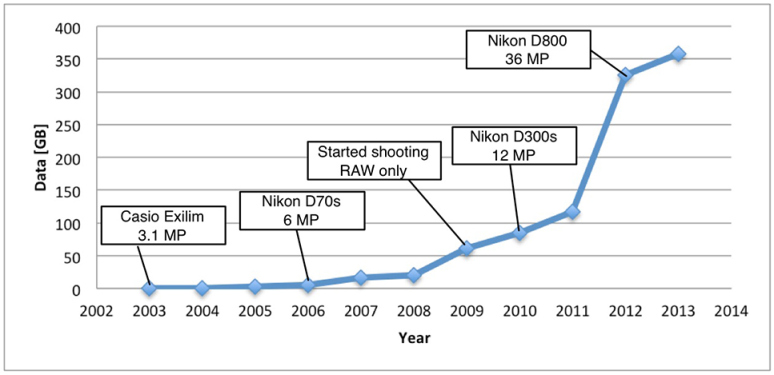I ran another archiving session that weekend and once again I thought “Boy, so much data, where is this going to end ?” The next though in that line was “How did the amount of data develop over the years ?” and so I decided to make a blogpost about it.
I went through my archive and gathered some numbers on the data volume per year. Here is the graph indicating the data increase (note: the graph shows the data volume per year, not an accumulated value).

pre 2003: My personal pre-digital era. The images I have in my archive are mainly scanned prints. There are still around 50 film rolls which wait to be scanned one day. Because most of those images only exist on paper or film I decided to leave them out of my statistical review and start with the first digital camera I owned.
2003 – My first digital camera was a Casio Exilim EX-Z30 with 3.1 MP. It was the simplest of the simple point-and-shoot cameras and it was okay for the first time. When I bought it I just wanted to snap pictures, not do serious photography. I emphasize the word “snap”. I was the kind of person who would walk around on parties, occasionally holding the camera into the room and taking an image. Nothing serious. I don’t have to mention the camera shot JPG only (well, there I did it anyway). Therefore the images were very small. In the first years I produced only around three GB in total.
2006 – I got my first DSLR, a Nikon D70s with 6 Megapixels. The D70s marks the era where I started taking photography seriously. Before that the concept of shutter speed and aperture was unknown to me (also because the Exilim allowed no control of the exposure parameters). But knowledge did not come over night, and therefore I continued shooting JPG (yes, I admit it). I did understand what RAW was, but could not grasp the concept why this should be so important.
2009 – At the beginning of 2009 I switched to shooting RAW only and KABOOM ! The annual data volume tripled from around 20 to 60 GB. End of 2009 (actually December 30th) I received my new camera – a Nikon D300s. Besides from leaping to a pro DX body this meant twice the resolution: 12 Megapixels and therefore larger RAW files. I kept on shooting with the D300s in 2010 and 2011.
2012 – I got my hands on one of the first D800 bodies which were shipped (Remember ? After an initial batch Nikon had some kind of manufacturing problem and further shipments of D800 bodies were delayed by months). With the D800 s#!t got real. Not only did I go to full frame but also the resolution tripled. Now an a$$-whooping 36 Megapixels ate away hard drive space like nothing I had seen before. One RAW file occupies around 50 Megabytes. That means with 20 images from the D800 you are at one Gigabyte. Phew. Totally had to learn to deal with that. Also the D800 offers serious video recording, which I started to experiment with (in order not to distort the above graph video files were not counted, just images).
2012-2014 – I sold the D300s and got a D610 as a second body. It has 24 Megapixels. Annual data volume still increasing, even though I try to discipline myself and keep as few images as possible. Modest results with that. If there was a D800-like camera with less Megapixels I’d take it because I personally do not need 36 Megapixels.
What ? What did you say ? Oh, go away with that totally overpriced no-video Hipster Nikon Df !
Bottom line:
The amount of data increased dramatically over the years. Especially the D800 and the appearance of two children in my life severely impacted the heap of Gigabytes I produce each year. Tackling such a Tsunami of images is challenging. I spend quite a lot of time sorting, retouching, exporting, archiving. Especially my paranoid backup strategy (three copies of my archive: Two on-site, one off-site) takes time because synchronizing an archive with > 1 TB makes the hard drives spin. Managing all that data is time-consuming, but I’m rather safe than sorry.


